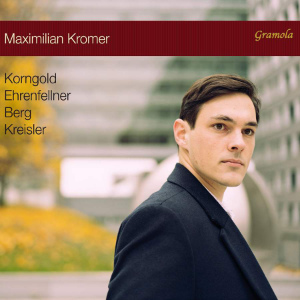
Erich Wolfgang Korngold (1897-1957)
Piano Sonata No.2 in E major Op.2 (1910)
Christoph Ehrenfellner (b.1975)
Neue Wiener Tänze Op.46 (2019)
Alban Berg (1885-1935)
Piano Sonata Op.1 (1907-1909)
Fritz Kreisler (1875-1962)
Liebesleid (1921, arr. Sergei Rachmaninoff)
Liebesfreud (1925, arr. Sergei Rachmaninoff)
Maximilian Kromer (piano)
rec. 2021/22 at Atelier 73, Unterretzbach, Lower Austria
GRAMOLA 99253 [63]
Maximilian Kromer, who describes himself as a Viennese interpreter with Russian roots, has devised an evocative programme paying homage to the city of his birth. The focus is on the turn of the 19th century and even though one work here hails from 2019 it is in itself an effective homage to the Vienna of a century earlier. The high chromaticism of the Korngold and Berg sonatas are intertwined with waltz recreations by Ehrenfellner and Kreisler ably abetted by Rachmaninoff in a nod to Kromer’s Russian heritage.
It is one thing to be aware that Erich Korngold was a child prodigy but another to hear such an accomplished and idiomatic work as the second Piano Sonata, published when the composer was just entering his teens. Its four movements are a heady mix of youthful impetuousness and vigour, colour and character, written marvellously if densely for the instrument and rich in lush harmony. The first movement opens with four bars of declamatory octaves which unveil the first motif; Korngold’s ear for melody is clear in the way he moulds this into lyrical theme that has hints of the Hollywood composer to come. The second theme is a simpler rising motif and a new section, impish and scherzo-like soon emerges whose playful character is a match to the Fairy Tale Pictures op.3 that he was writing at the same time. The writing is thickly textured, crammed full of octaves and chordal passages and Korngold explores the whole range of the keyboard almost as if it was too small for his supercharged imagination. A scherzo follows that also opens with a motif in octaves, its outline sharing similarities with the first movement’s first theme. The Vienna of the waltz kings comes to life in its second theme as well as the carefully notated little ritardandi in every other bar of the grand waltz theme. The trio is a waltz of another kind, harking back to Schubert and his Ländler. The intense, brooding third movement is startling in its own right, nominally in C minor but bringing in enigmatic turns of harmony from the very first bar. Despite the fact that Korngold explores a variety of tonal centres in just the first twelve bars he effortlessly arrives back in C minor ready for the next exploration. Its waves of passionate writing lead to two climaxes and the second leaves us in the major key, still sidling into other harmonies but ultimately settling down for a tranquil ending. The finale is all sunlight in contrast to the twilight world of the largo; its jovial first theme, chordal à la Schumann, is light hearted, bright and sharp edged with dotted rhythms while the more lyrical second theme in triplets is smooth textured. A middle section has a more acerbic and slightly demented view of the opening theme but normality soon returns and, as a nod to continuity, Korngold plays the opening octaves theme of the sonata before an affirmative E major ending. I have enjoyed getting to know this larger than life sonata from a composer bursting with ideas and technique desperate to show off all he can do.
In contrast to the huge dimensions of Korngold’s Sonata stands Alban Berg’s much more familiar Sonata, written at the same time – the booklet whimsically imagines a Vienna as 1909 closes and 1910 opens, Korngold sitting at his parent’s kitchen table composing his second sonata while Berg was toiling on his just over a mile away. It is a decidedly more compact work in one movement, less than half the length of the Korngold and as the booklet points out its spirit and harmonic language point less to Richard Strauss than to Mahler; I can hear hints of Busoni and late Scriabin as well though the latter’s later sonatas date from the five or six years after this sonata was published. The extravagant passion found in Korngold is more restrained here though Kromer navigates its colder intensity with equal ease.
Christoph Ehrenfellner is a Salzburg born composer, conductor, violinist and singer whose career began in the Vienna Boys’ Choir. His New Viennese Dances are dedicated to Kromer and the inspiration is clear in the work’s subtitle – Grande Valse de Concert – au souvenir de F. Schubert et M. Ravel. The opening of this very tonal work sounds like an vaguely jazz-like improvisation on waltz themes with hints of Schubert along the way, sauntering chromatically through a series of keys before a sudden, startling change of mood brings an almost grotesquely comic second waltz. Waltz number three floats in like a mist descending, blurring all sharp edges, the waltz theme almost hypnotic in its surging. The fourth is different again, gracious and vivacious, draped in arabesques before the final waltz appears, its bass opening reminding one of Ravel’s la Valse and if Ehrenfellner goes his own way he creates the same kind of imagery that Ravel conjured up. This is an imaginative and vivid work and Kromer delights in its contrasts and virtuosic writing as he does in Rachmaninoff’s equally resplendent versions of Kreisler’s Old Vienna Dances, Liebesleid and Liebesfreud. He employs a subtle rubato in Leibesleid and the final A major grazioso e dolce is as poised and elegant as one could wish while he is flirtatious and characterful in Liebesfreud.
I love the balance of this recital, with its intriguing mix of familiar and unfamiliar scores and Kromer is a skilful player, unfazed by the technical demands and able to bring fresh colour and character to the varying moods in these diverse portraits of a grand old city.
Rob Challinor
Help us financially by purchasing from





















